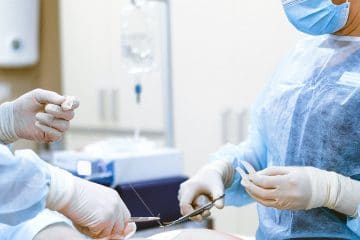Emergency Gallbladder Surgery
Gallbladder is a small, tear-shaped organ located under the liver. Its main function is to store bile. Despite the size, it can cause serious health problems and one might even need an emergency surgical operation to solve them. In the article below, you will find everything about cholecystectomy (the medical term for gallbladder removal), who might need this procedure, how it is performed, what are the complications after surgery and more.
Why it’s done
Gallbladder surgery is most commonly needed to treat complications caused by gallstones. Depending on symptoms and patient severity, cholecystectomy can be an emergency or scheduled procedure. Here are some clinical scenarios when your doctor may recommend surgical removal of the gallbladder.
- Symptomatic cholelithiasis – Cholelithiasis is a medical term for gallstone disease. Many people with gallstones do not have any complaints, but some might experience abdominal pain, fever, indigestion, etc. In addition, they may trigger some other complications like inflammation of the gallbladder, biliary system and pancreas.
- Asymptomatic cholelithiasis with associated risks – Even if a patient does not suffer from any symptoms of gallstones at all, doctors may still advise removing the gallbladder. For example, if there are findings like polyps, large stones or calcified organ walls, that indicates a high risk of developing gallbladder cancer. In addition, those who have problems with the immune system, hemolytic anemia or plan to have gastric bypass surgery are at increased risk of developing biliary system complications and might need their gallbladder removed.
- Acute cholecystitis – or the inflammation of the gallbladder is one of the most common reasons for ER visits. In more than 90% of cases, responsible for this are gallstones. They obstruct gallbladder ducts and cause distention and inflammation of this organ. If the patient is otherwise healthy and does not have risk factors associated with anesthesia, emergency gallbladder surgery is performed as soon as possible.
While in most cases differentiating between acute and non-emergency situations is quite easy, sometimes it becomes tricky to figure out whether or not a patient can go home and return for scheduled surgery later. According to Mayo clinic study 1 in 5 ER patients with gallbladder pain who were sent home to schedule, surgery returned to the emergency department within a month needing emergency cholecystectomy.
Emergency Gallbladder Surgery – How is the gallbladder removed?
There are two surgical ways of removing this organ: laparoscopic and open cholecystectomy. Both require general anesthesia. This means you will be asleep during the whole procedure and will not feel any pain.
Laparoscopic Cholecystectomy
This is the most common approach. Your surgeon will make four small incisions. Each one will be approximately half an inch (1.27 cm) long. One of the incisions is made near the navel. The surgeon will insert an instrument called a laparoscope through this incision. A laparoscope is a thin tube with a video camera at the end. It is connected to a large screen in the operation room and is used to visualize your internal organs.
Then carbon dioxide is pumped into the abdomen to expand it. The result is a space that grants the surgeon access to your organs and tissues. Through the remaining holes, other instruments are inserted to remove the gallbladder. Laparoscopic removal takes about 1–2 hours.
The biggest advantage is that this approach is minimally invasive and puts less stress on your body. As a result, patients are able to return home on the next day of surgery and the recovery process takes less time.
Open Cholecystectomy
Sometimes it is not possible to remove the gallbladder laparoscopically. The reason for this may be severe gallbladder inflammation or scar tissue from previous surgeries. In such situations, gallbladder needs to be removed through a larger incision that is made from top to bottom in the center of the abdomen.
Complications of gallbladder surgery
Complications can be chronologically divided in two categories: early and delayed. Early postoperative complications include bleeding, bowel injury, surgical site infections and bile leak. Keep in mind that even if you are undergoing laparoscopic surgery, occasionally during the operation transition to open surgery may be necessary and you might end up with a bigger scar. The delayed complications might be postoperative chronic diarrhea, hernias at the incision site and postcholecystectomy syndrome, which includes pain and onset of new gastrointestinal symptoms after surgery.
Recovery and postoperative period
Recovery time depends on the type of procedure. For laparoscopic surgery, you leave the hospital on the next day and will most likely be able to return to your usual activities after 1 week. After open surgery, you need to stay 3-5 days at the hospital and it will take 6-8 weeks to recover fully. In both cases patients will need to be on a low-fat diet for some time postoperatively.
Emergency Gallbladder Surgery – Summary
Modifications in nutrition and other measures can not get you rid of gallstones and its associated complications. Cholecystectomy has been proven to be the most effective treatment for recurrent gallstone problems. The gallbladder is not an essential organ like the heart and liver. In fact, it is not even absolutely necessary for a healthy digestive system. So it can be removed without any long-term consequences. Both laparoscopic and open surgeries are safe ways to deal with the problematic gallbladder.
See Also
References
2. https://www.ncbi.nlm.nih.gov/books/NBK448145/
3. https://clinicaltrials.gov/ct2/show/NCT02630433
4. https://next.amboss.com/us/article/V30Ghf?q=cholecystectomy#Zc60317779b3347fefaf91a3415fb3682


